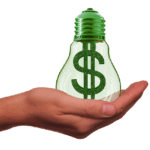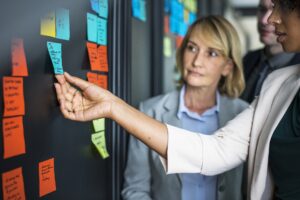By Lynn Grinnell, PhD, LEED AP O+M (with my colleague, Greta Kishbaugh)
Outreach Using Sustainable Innovation
No, I am not the hero. The hero is the unconventional student who overcomes obstacles and leaps into action inventing unique solutions to global problems – the next generation of entrepreneurs. I hope my colleague, Greta, and I can be the storytellers. We are two faculty members, one an entrepreneur and one a sustainability prof, at a state college that happens to have one of the best sustainability management programs in the country. Check it out:
This has been a whirlwind of a summer so far, and it’s only just the beginning. My colleague and I (inspired by our new boss) have discovered a new script for teaching college – it starts with High School students and other heroes from unlikely places, adds a touch of the real-world, mixes in cutting-edge technology (drones, virtual/augmented reality, 3D printing, etc.), common ground, sustainable values, and some really useful, hands-on problem-solving tools. The plot requires some experiential learning theory over it all, and you can experience something awesome! Are you the next hero? Or the next storyteller?
The Prequel. Let me give you a little background. In the story so far, higher education is getting blown up. We are being attacked from many directions. For some time, we’ve expected technology to replace front-line workers like fast food cooks and truck drivers. Now, AI is predicted to replace wide swaths of white-collar jobs that have required college degrees.  Some folks I respect, like Mike Rowe, have pointed out that a lot of current jobs don’t need a college degree, so college graduates are often underemployed or unemployed, accompanied by massive student loan debt. What’s more, there are unhappy stakeholders (parents) who don’t recognize their kids after four years of their listening to values they don’t like, so they are looking for alternatives. Finally, there was Covid. Everyone went online, and most students don’t really like online, but they don’t want to come back to class either. The sum total of all these converging effects is a big downslide in the numbers: enrollment in colleges across the nation is down significantly. So, what do we do about it? How do we make college relevant (and affordable) again?
Some folks I respect, like Mike Rowe, have pointed out that a lot of current jobs don’t need a college degree, so college graduates are often underemployed or unemployed, accompanied by massive student loan debt. What’s more, there are unhappy stakeholders (parents) who don’t recognize their kids after four years of their listening to values they don’t like, so they are looking for alternatives. Finally, there was Covid. Everyone went online, and most students don’t really like online, but they don’t want to come back to class either. The sum total of all these converging effects is a big downslide in the numbers: enrollment in colleges across the nation is down significantly. So, what do we do about it? How do we make college relevant (and affordable) again?
Start with unconventional students (in this case, High School students). Dual enrollment is not really a new idea, but in case you don’t know what it is, this is a program that has high schoolers taking college classes so that they can graduate high school with two degrees, a high school diploma and an Associate’s degree – which has the awesome benefit of saving two years of college tuition, since property taxes that fund the k-12 system are the funding source. There are other unconventional students, as well – adults who never thought they were college material (and they weren’t, by conventional standards, but they are really smart. It’s up to us to reach out to them and help them to be successful.) Our heroes are in unlikely places. If we really have something worthwhile to offer, we need to seek them out. And if you are the unconventional hero we are seeking, join us for the adventure of a lifetime.
Add the real world. One of the comments we get most often from job-seeking graduates is that so many openings require experience, which is the one thing they don’t have. It’s up to us to help them get that experience by working with real-world businesses.  We offer local businesses, city/county governments, non-profits, churches, and schools the opportunity to use our students to develop sustainability improvements for their organizations or locales. With our expertise to guide them, our students create practical solutions to their clients’ problems. Our heroes get experience to add to their resume and connections to future job opportunities. This is a win-win scenario.
We offer local businesses, city/county governments, non-profits, churches, and schools the opportunity to use our students to develop sustainability improvements for their organizations or locales. With our expertise to guide them, our students create practical solutions to their clients’ problems. Our heroes get experience to add to their resume and connections to future job opportunities. This is a win-win scenario.
Mix in cutting-edge technology. This is a great carrot for our heroes.  They get the opportunity to learn how to use cutting-edge technology like drones, 3D printers, VR/AR, and app development tools to create a model or visual representation of their invention or process improvement. This gives our heroes practice on equipment they might not have, and it’s a lot of fun.
They get the opportunity to learn how to use cutting-edge technology like drones, 3D printers, VR/AR, and app development tools to create a model or visual representation of their invention or process improvement. This gives our heroes practice on equipment they might not have, and it’s a lot of fun.
Common ground, sustainable values. We live in a polarized society right now, so there is resistance to the very idea of sustainability in many quarters, especially in business, where profit is necessary for survival, and eco-friendly or people-friendly options don’t seem viable. But we believe that both sides can come together on many sustainability issues.  For our Green Innovations summer program, we are teaching the kids how to use the B Corps certification standard, which offers a lot of flexibility for making improvements that really benefit people, planet, and profit/prosperity. With a bottom-up approach tailored to the specific situation (rather than a top-down, one-size-fits-all approach that seems to be the norm) and an understanding of the client’s values and priorities, our heroes can propose improvements they will love.
For our Green Innovations summer program, we are teaching the kids how to use the B Corps certification standard, which offers a lot of flexibility for making improvements that really benefit people, planet, and profit/prosperity. With a bottom-up approach tailored to the specific situation (rather than a top-down, one-size-fits-all approach that seems to be the norm) and an understanding of the client’s values and priorities, our heroes can propose improvements they will love.
And hands-on… Abstract liberal arts courses were some of my favorites and do teach you to think critically, but they don’t have immediate use. How much we learn is affected by “transfer theory,” meaning that the more distance there is between what students learn in class and what they need on the job, the harder it is to transfer the knowledge [1]. Research shows that people forget 95% of what they learn via lecture [2], so we like to give our heroes realistic, hands-on practice. Then, they are more likely to be able to use their skills when needed on the job. You can see a great example of this in The Last Starfighter (yes, I know it’s an obscure reference), in which our hero practiced with a video game to prepare him for saving the galaxy (turns out, the game was an exact replica.)
Problem-solving tools. What is a tool, in the parlance of business?  It’s not a physical tool, like a hammer or computer, but it is a technique that helps analyze or organize information needed for planning [3]. Tools are often used by work teams, with big flip charts or software to carry them from one tool to the next, so they can create and carry out a vision for the future. The Design Thinking process [4] in entrepreneurship gives a set of powerful tools for creating innovative solutions. (Suggested resources are below.) Giving our heroes a set of tools for their journey gives them power to influence others to do good.
It’s not a physical tool, like a hammer or computer, but it is a technique that helps analyze or organize information needed for planning [3]. Tools are often used by work teams, with big flip charts or software to carry them from one tool to the next, so they can create and carry out a vision for the future. The Design Thinking process [4] in entrepreneurship gives a set of powerful tools for creating innovative solutions. (Suggested resources are below.) Giving our heroes a set of tools for their journey gives them power to influence others to do good.
Use experiential learning theory. The premise of experiential learning theory is that we can best learn from experience if we process it afterwards for lessons that can be applied to the next time [5]. This is used in the military after every training mission, but it can be used after any immersive learning experience. It’s a tool our heroes can use to make every day better – for themselves, their jobs, and the world. Think Maverick! (The debriefing starts around 55 seconds into the video)
I’ve used these stories to give you one possible future of education – a positive vision we are pursuing at St. Petersburg College. We are writing our own stories this summer in partnership with the Gentlemen’s Quest of Tampa and in our own Green Innovations summer program, and we will be back to tell those stories.
Now, how about you? If you want to be a hero, check us out – we have some truly innovative programs you can leverage for a great job. If you are an educator who wants to change the world, you will need help. You will need heroes. And you will need to be their guide. How will you do it? Check back with us for more…
Want to learn more? Check out these resources.
- Garavan, T. & Hogan, C. (2021). Transfer of Training in Organisations: (Learning & Development in Organisations series #12). https://amzn.to/42KZTeX.
- E. J. Wood (2004) Problem-Based Learning: Exploiting Knowledge of how People Learn to Promote Effective Learning, Bioscience Education E-journal, 3-5 available at http://www.bioscience.heacademy.ac.uk/journal/vol3/beej-3-5.asp
- Grinnell, L. (2019). How to Start a Green Team. American Sustainability. https://amzn.to/43O6syQ.
- IDEO (n.d.), Design Thinking History. https://designthinking.ideo.com/history.
- Kolb, A. & Kolb D. (2017). The Experiential Educator: Principles and Practices of Experiential Learning. https://amzn.to/442s9uI
